
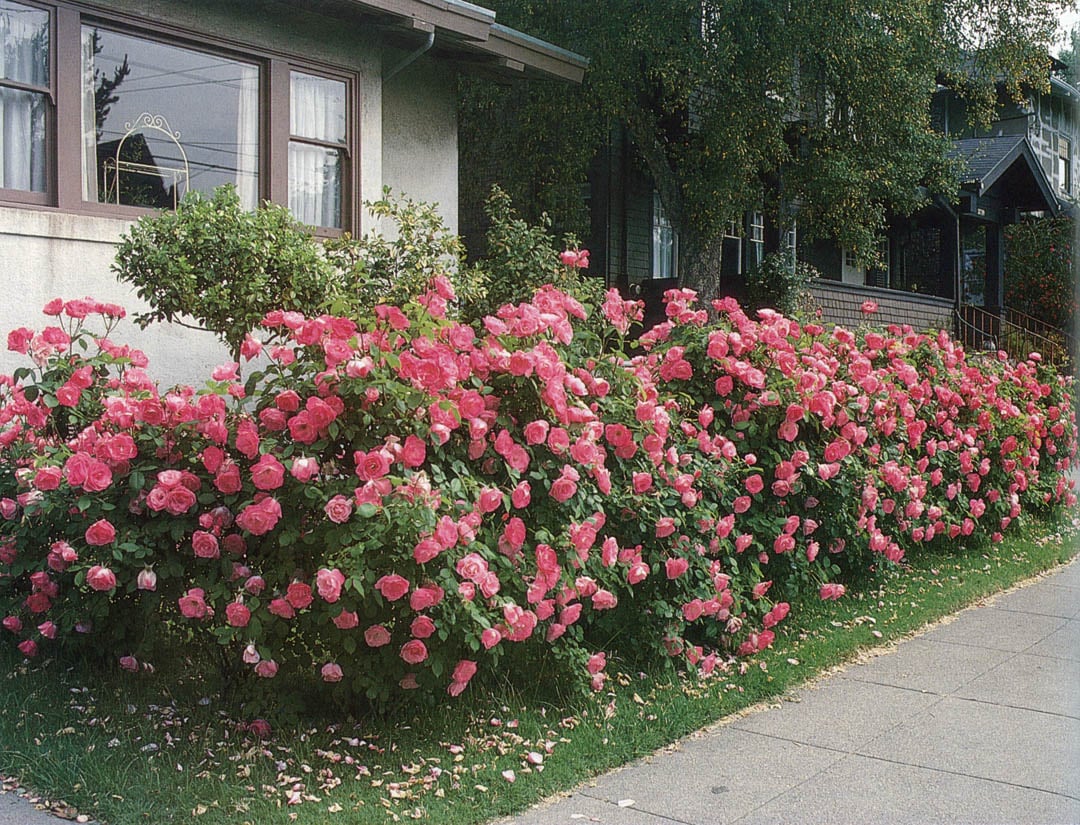
Contributor
- Topics: Archive, Plants You Need
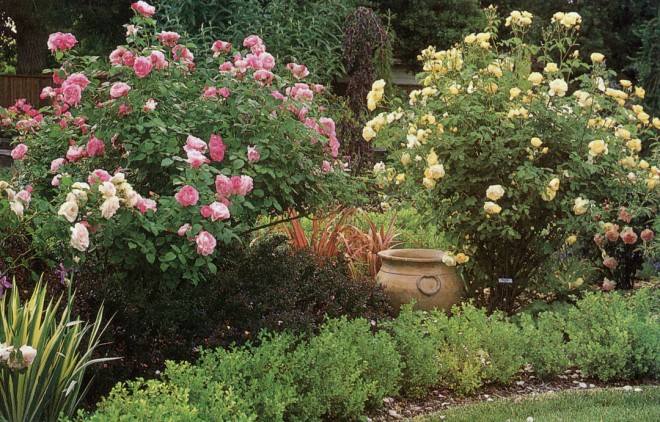
Present-day landscaping trends and those for the foreseeable future demand the use of easily maintained shrubby plants. No other group or family of plants can possibly fulfill this role more successfully than roses — more specifically, shrub roses — while, at the same time, providing a succession of flowers. Several modern rose breeders saw this trend long before me and already there is a wide range of roses for this purpose. I suspect several more exciting new ones are on the way.
Peter Beales, Roses
Although roses are the best loved flowers in the world, there are still many gardeners who hesitate to include them in their own landscapes because of their reputation for needing so much care. Roses are believed to be prissy prima donnas needing frequent feedings of fancy formulations, at least semi-monthly spraying with chemical fungicides and insecticides, and rigorous pruning and shaping. But, thanks to the current rose revolution, that can no longer be said. There is a new group of roses, sold as shrub roses, that don’t demand this care, yet produce masses of colorful flowers.
Until recently gardeners could select roses from just a few categories. Hybrid tea roses, developed about a hundred years ago, produce one flower per stem on bushes four to six feet tall. They are the familiar florists’ roses. Floribundas were developed in the 1930s and 1940s as free-flowering, hardier and tougher than hybrid teas. Another class of modern roses came into existence in 1954 with the development of ‘Queen Elizabeth’, which at that time didn’t fit any classification because of its great height and clusters of hybrid-teashaped flowers. The category “grandiflora” was created especially for this rose. Another category of modern rose is the miniature-diminutive versions of hybrid tea or floribunda roses that grow to just one or two feet tall. They are derived from plants of Rosa chinensis ‘Minima’, found in 1918 decorating a window ledge in Switzerland.
In the background until recently were the old-fashioned roses, such as the damasks, Bourbons, and moss roses, some of them — Rosa gallica, for example — known to gardeners 500 years ago. They are returning to favor as heritage roses among gardeners who grow them along with some of the wild and near-wild hybrids almost unpruned as ordinary garden shrubs.
In the last decade another type has emerged, the modern shrub roses. They come in many shapes and forms, from groundcovers that grow less than a foot tall and cover large areas to nicely rounded, well behaved small mounds of two to three feet tall, to arching shrubs producing graceful fountains of colorful flowers and lush foliage. All-America Rose Selections (AARS) has a category in which to evaluate these new roses. They are valuable additions to gardens because the plants are attractive and free-flowering from spring through fall. Many repeat their cycle so quickly that they are in bloom the entire rose season. “The rules of classification are changing,” says Dick Young, owner and founder of Young’s American Rose Nursery in Huron, Ohio. “Shrub roses are the big trend.” Last year Young’s nursery introduced seven rose varieties in its Town and Country series, developed especially for landscape settings, with more to come this year and next.
Botanically, all roses are shrubs, but not all rose bushes are shrub roses. According to Tom Carruth, hybridizer for Weeks Roses in Upland, California, shrub roses “should bloom profusely and repeat quickly, naturally resist the major fungal diseases (blackspot, rust, powdery mildew), be hardy in most climates, require no pruning, just occasional shaping, and have an attractive, usable habit with abundant foliage.”
Ignored in this definition is the shape of the flowers; they are not required to meet exhibition standards, the elongated form associated with hybrid tea show roses. Keith Zary, hybridizer for Jackson & Perkins, the largest retail and mail-order rose company in the United States, explains: “A hundred years ago rose exhibitors were a powerful influence and pushed breeders into stressing the flower and ignoring the plant. That influence has changed considerably.”
While pleasing form and fragrance are still desirable qualities in rose blossoms, many rose hobbyists are buying roses to enjoy in landscapes and bouquets — few are exhibiting them. They no longer require the high-centered, elongated flower prized in rose shows. They are also turning in their toxic chemicals, protective gear donned when spraying away spores and insects, and demanding easy-care plants that thrive in a variety of climates and conditions.
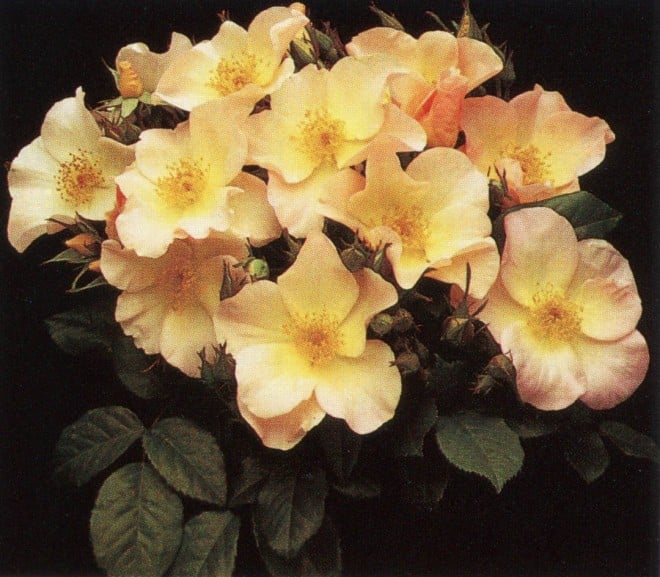
The rose revolution of the 1990s is a direct result of the green revolution of the 1960s and 1970s. “When the green revolution gained popularity in the 1970s,” says Zary, “rose breeders acknowledged the environmental problems associated with fungicides and insecticides. They began working with species roses, and now we’ re seeing the fruits of their efforts.” In the past few years a significant number of shrub roses have come on the market: ‘Bonica’, ‘Flutterbye’, ‘Lady of the Dawn’, ‘Sally Holmes’, and ‘Rockin’ Robin’ this year, with more to come soon.
Two significant roses heralded the current trend. The first was in 1958, when the Kordes family in Germany introduced a white floribunda we know as ‘Iceberg’. It revolutionized rose growing, and is now considered one of the world’s top ten roses, highly regarded in landscape settings. The second was a pink rose named ‘Simplicity’, which Jackson & Perkins introduced to America in 1978. Marketed as a living fence and recommended for use as a hedge or mass landscape planting, ‘Simplicity’ has become the number-one selling rose in America, with more than thirty million sold to date. The late Bill Warriner developed ‘Simplicity’ from ‘Iceberg’. The company also offers ‘Red Simplicity’ and ‘White Simplicity’, although the original pink rose is still the most popular. The phenomenal success of this rose influenced other hybridizers. It proved to marketers that shrubs could be sold profitably.
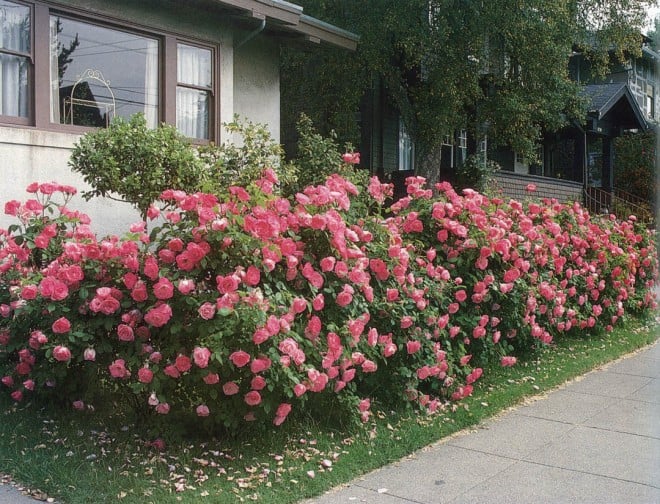
The major American rose companies began concentrating on developing healthy, robust plants that flower freely and in many cases are self-cleaning to reduce the labor of dead-heading. Across the Atlantic Ocean the venerable European hybridizers, Kordes and Tantau in Germany, Meilland of France, Poulson of Denmark, and Harkness and Dickson of England, also developed and marketed these new landscape roses.
Another Englishman, David Austin, influenced the rose revolution by hybridizing fragrant roses in the form and style of heritage roses, combining the cup-shaped, flat-faced flowers of old roses with the repeat-flowering, restrained growth of modern roses. These new Austin, or English, roses are rapidly gaining popularity, although most of them aren’t disease free or cold hardy. Gardeners who add them to their landscapes are willing to overlook their tendency to mildew, rust, or blackspot because of the overwhelming fragrance, charm, and hues.
Clair Martin, rose curator for the Huntington Botanical Gardens in San Marino, California, was among the first to acquire and evaluate Austin roses when they became available commercially. He oversees a hundred Austin varieties at the Huntington and grows another twenty-five in his own garden, where these new English roses account for forty percent of his landscape. He notes that all roses vary in performance by region, and advises viewing their growth and performance at local nurseries and public gardens.
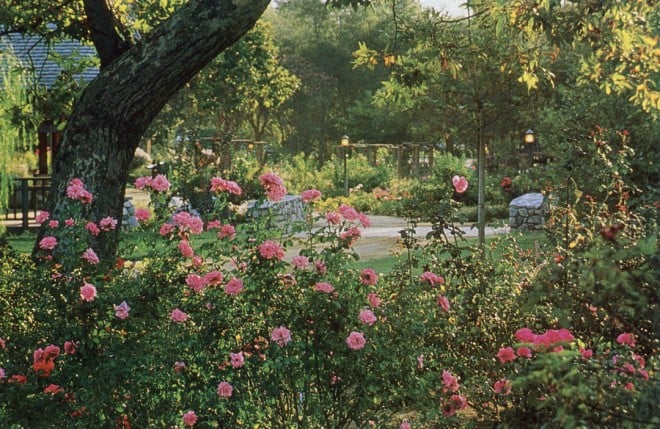
The new five-acre International Rosarium at Descanso Gardens in La Cañada Flintridge, California, also contains a large number of Austin and other shrub roses among the 4,000 bushes on display. This garden was designed to showcase roses growing informally, landscaped with other shrubs, perennials, and annuals. The verdant grass walkways and meandering paths throughout the beds and twenty garden vignettes evoke the mood of strolling through an expansive residential landscape. While serious lovers of roses can trace their development from original species through all categories of early and heritage roses on to the present, garden hobbyists can also derive practical ideas for their own landscapes.
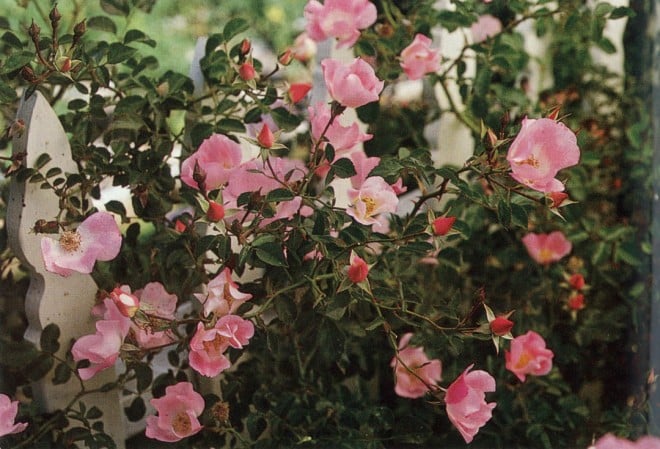
The past few years have seen a proliferation of shrub roses, and last year included a significant number of groundcovers such as ‘Jeepers Creepers’ and ‘Cliffs of Dover’. Although the first attempts at groundcovers were limited by their failure to flower repeatedly throughout the year, this fortunately has been solved. The new groundcovers are ideal for slopes, large vistas, or even hanging baskets. Currently available in red, white, and pink, yellow and other colors will be joining the selection in just a few years.
Another breakthrough is the introduction of roses for cold climates. The new Morden series is hardy to Zone 5. Until these cold-hardy roses were developed, gardeners in cold regions had to protect roses by covering them in winter with an insulating material such as straw or pine branches and still risk losing them at low temperatures.
American hybridizer Ralph Moore has been working with Rosa rugosa, a tough and disease-resistant native of Central Asia and Japan. Several cultivars of R. rugosa have been in gardens for a hundred or more years, showing how well they survive. Some of Moore’s new roses are cold-hardy without protection and also flower more than once. Two of these, ‘Linda Campbell’ and ‘Topaz Jewel’, are especially well suited to cold climates, where they are more likely to flower repeatedly. Their beauty is also enhanced by colorful red hips in fall. On the horizon are miniature rugosas, and modern moss roses having that green crest on the buds that fascinated the Victorians.
A rose that is certain to make an impact on American gardens is ‘Flower Carpet’, introduced in August 1995 as the “Eco Rose.” Already a hit in Australia and winner of awards in Germany, France, England, and the Netherlands, ‘Flower Carpet’ is noted for exceptional disease resistance and free flowering. Grown on its own roots it is reputed to flourish in both hot regions and where frost is common, from Zones 2b through 11 (Calgary, Canada, to Miami, Florida). The plant grows in a mound up to three feet, and one plant will cover a three-foot circle. It flowers profusely in clusters of iridescent pink. A similar rose with white flowers will be introduced next year, and plants with soft pink, yellow, and red flowers will follow.
[sidebar]
Shrub Roses Recommended by Rose Hybridizers Tom Carruth and Keith Zary
Groundcovers:
‘Cliffs of Dover’, white
‘Flower Carpet’, pink
‘Jeepers Creepers’, white
‘Watermelon Ice’, pink
‘Ralph’s Creeper’, red
Shrubs:
‘All That Jazz’, orange blend
‘Bonica’, pink
‘Carefree Delight’, pink
‘Flutterbye’, orange blend
‘Lace Cascade’, white
‘Lady of the Dawn’, white/blush pink
‘Mirabella’, yellow
‘Sally Holmes’, white
‘Simplicity’, red, white, or pink
David Austin Shrub Roses:
‘English Garden’, yellow
‘Fair Bianca’, white
‘Heritage’, light pink
‘Mary Rose’, dark pink
‘Prospero’, deep red
‘Tamora’, apricot
Note: Shrub roses ‘Lace Cascade’, ‘Lady of the Dawn’, and ‘Sally Holmes’ can be trained as climbers
[/sidebar]
The new shrub roses are being grown in many gardens throughout the nation, although ease of care may vary by climate. In cold regions, even though shrub roses are hardier than other modern roses, they perform better with some winter protection. Plant them with the bud unions one to two inches below soil level. In warm climates, such as southern California and the Southwest, plant shrub roses with the bud unions at soil level and then mulch the ground to help keep the soil cool and to retain moisture in summer.
Size of shrub will vary by climate. Roses grown in Zones 9, 10, or 11 grow larger than stated in catalogs. Roses such as ‘Sally Holmes’ and ‘Lady of the Dawn’ become climbers in regions of abundant sunshine. Disease resistance also varies by location, and the garden hobbyist’s tolerance of disease varies as well. Unlike exhibitors who strive to produce the perfect rose, free from blemishes, garden enthusiasts can overlook mildew, rust, even blackspot, patiently waiting for the episode to pass. Others use natural controls such as baking soda solution to mitigate the effects of fungal attacks.
Pruning these new shrub roses is much simpler than dealing with hybrid teas or floribundas. Many are self-cleaning; they drop their flowers after blooming. The sprawling groundcover roses need only shaping, as is true of the taller shrubs, which can be manicured to suit the landscape setting. Remove dead wood at the end of the flowering season, and cut back growth to one-third or one-half, depending on variety. Less vigorous plants are usually pruned harder to encourage new growth from low down.
Few plants can equal the rose for flower power, productivity, and charm. Even by those who once thought them demanding, these new landscape roses can be enjoyed with minimum effort.
The China Rose
The China rose is the foundation species upon which all our modern roses are built, whether they be bedding roses or shrubs or perpetual-flowering climbers. Its influence in rose-breeding over nearly two hundred years has been so great, so overwhelming, and so popular that it is difficult to see where we should have been without it. We are so used to thinking of roses in terms of hybrid teas and floribundas that we are apt to forget that these are, comparatively, very new and specialized, and they owe more than half their success and éclat to the China rose.
Our garden China roses are shrubs of small to medium growth, according to the local climate, and have smooth wood, reddish when young and sparsely set with small, handsome, dark red prickles. The leaves are also sparsely borne, with 3 to 5 pointed segments; they are smooth, richly tinted with red-brown when young, and contribute greatly to the general color of the plants. (This leaf-color is reproduced in its most intense richness in such roses as ‘Donald Prior’ and ‘Rosemary Rose’, both modern floribundas.) The flowers have 5 or more rather limp petals of silky texture, making rather a shapeless flower after their first opening, especially in the singles.
The Graham Stuart Thomas Rose Book
Share:
Social Media
Garden Futurist Podcast
Most Popular
Videos
Topics
Related Posts

Ground Up Science for Greener Cities with Garden Futurist Dr. Alessandro Ossola
Spring 2023 Listen to the Podcast here. Alessandro Ossola is a scientist who gets very excited about the challenge of climate change allowing for an

Readying Urban Forests for Climate Realities with Garden Futurist Dr. Greg McPherson
Winter 2023 Listen to the Podcast here. “Going from the mow and blow to a more horticulturally knowledgeable approach to maintaining the landscape. And that

Welcome, Greywater, to the Garden
Summer 2022 Oh, summer: delightful warm air, tomatoes swelling on the vine, fragrant blooms on an evening stroll. When it’s warm and rainless, how is

Big Tree-Data and Big-Tree Data with Garden Futurist Matt Ritter
Summer 2022 Listen to the full Garden Futurist: Episode XV podcast here. We are in an environmental crisis right now in many parts of California








Responses